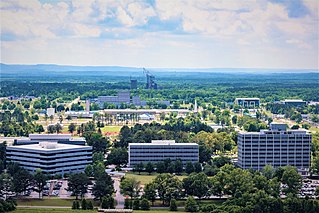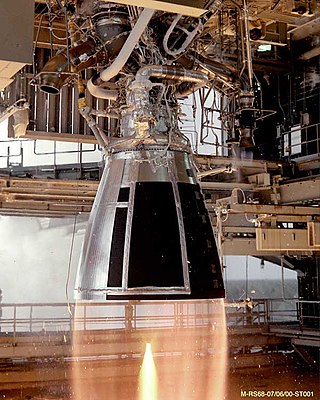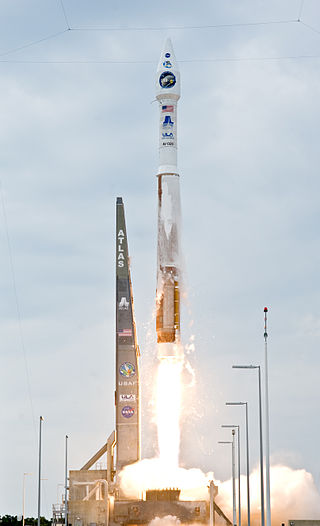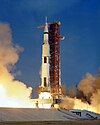Related Research Articles

The Space Shuttle is a retired,partially reusable low Earth orbital spacecraft system operated from 1981 to 2011 by the U.S. National Aeronautics and Space Administration (NASA) as part of the Space Shuttle program. Its official program name was Space Transportation System (STS),taken from a 1969 plan for a system of reusable spacecraft where it was the only item funded for development.

The Centaur is a family of rocket propelled upper stages that has been in use since 1962. It is currently produced by U.S. launch service provider United Launch Alliance,with one main active version and one version under development. The 3.05 m (10.0 ft) diameter Common Centaur/Centaur III flies as the upper stage of the Atlas V launch vehicle,and the 5.4 m (18 ft) diameter Centaur V is being developed as the upper stage of ULA's new Vulcan rocket. Centaur was the first rocket stage to use liquid hydrogen (LH2) and liquid oxygen (LOX) propellants,a high-energy combination that is ideal for upper stages but has significant handling difficulties.

The George C. Marshall Space Flight Center (MSFC),located in Redstone Arsenal,Alabama,is the U.S. government's civilian rocketry and spacecraft propulsion research center. As the largest NASA center,MSFC's first mission was developing the Saturn launch vehicles for the Apollo program. Marshall has been the lead center for the Space Shuttle main propulsion and external tank;payloads and related crew training;International Space Station (ISS) design and assembly;computers,networks,and information management;and the Space Launch System. Located on the Redstone Arsenal near Huntsville,MSFC is named in honor of General of the Army George C. Marshall.

Rocketdyne was an American rocket engine design and production company headquartered in Canoga Park,in the western San Fernando Valley of suburban Los Angeles,in southern California.

Delta II was an expendable launch system,originally designed and built by McDonnell Douglas,and sometimes known as the Thorad Delta 1. Delta II was part of the Delta rocket family and entered service in 1989. Delta II vehicles included the Delta 6000,and the two later Delta 7000 variants. The rocket flew its final mission ICESat-2 on 15 September 2018,earning the launch vehicle a streak of 100 successful missions in a row,with the last failure being GPS IIR-1 in 1997.

A spaceplane is a vehicle that can fly and glide like an aircraft in Earth's atmosphere and maneuver like a spacecraft in outer space. To do so,spaceplanes must incorporate features of both aircraft and spacecraft. Orbital spaceplanes tend to be more similar to conventional spacecraft,while sub-orbital spaceplanes tend to be more similar to fixed-wing aircraft. All spaceplanes to date have been rocket-powered for takeoff and climb,but have then landed as unpowered gliders.

The Saturn IB was an American launch vehicle commissioned by the National Aeronautics and Space Administration (NASA) for the Apollo program. It uprated the Saturn I by replacing the S-IV second stage,with the S-IVB. The S-IB first stage also increased the S-I baseline's thrust from 1,500,000 pounds-force (6,700,000 N) to 1,600,000 pounds-force (7,100,000 N) and propellant load by 3.1%. This increased the Saturn I's low Earth orbit payload capability from 20,000 pounds (9,100 kg) to 46,000 pounds (21,000 kg),enough for early flight tests of a half-fueled Apollo command and service module (CSM) or a fully fueled Apollo Lunar Module (LM),before the larger Saturn V needed for lunar flight was ready.

Delta IV was a group of five expendable launch systems in the Delta rocket family introduced in the early 2000s. Originally designed by Boeing's Defense,Space and Security division for the Evolved Expendable Launch Vehicle (EELV) program,the Delta IV became a United Launch Alliance (ULA) product in 2006. The Delta IV was primarily a launch vehicle for United States Air Force (USAF) military payloads,but was also used to launch a number of United States government non-military payloads and a single commercial satellite.
The Saturn I was a rocket designed as the United States' first medium lift launch vehicle for up to 20,000-pound (9,100 kg) low Earth orbit payloads. The rocket's first stage was built as a cluster of propellant tanks engineered from older rocket tank designs,leading critics to jokingly refer to it as "Cluster's Last Stand". Its development was taken over from the Advanced Research Projects Agency in 1958 by the newly formed civilian NASA. Its design proved sound and flexible. It was successful in initiating the development of liquid hydrogen-fueled rocket propulsion,launching the Pegasus satellites,and flight verification of the Apollo command and service module launch phase aerodynamics. Ten Saturn I rockets were flown before it was replaced by the heavy lift derivative Saturn IB,which used a larger,higher total impulse second stage and an improved guidance and control system. It also led the way to development of the super-heavy lift Saturn V which carried the first men to landings on the Moon in the Apollo program.

The Boeing X-37,also known as the Orbital Test Vehicle (OTV),is a reusable robotic spacecraft. It is boosted into space by a launch vehicle,then re-enters Earth's atmosphere and lands as a spaceplane. The X-37 is operated by the Department of the Air Force Rapid Capabilities Office,in collaboration with United States Space Force,for orbital spaceflight missions intended to demonstrate reusable space technologies. It is a 120-percent-scaled derivative of the earlier Boeing X-40. The X-37 began as a NASA project in 1999,before being transferred to the United States Department of Defense in 2004. Until 2019,the program was managed by Air Force Space Command.

The Aerojet Rocketdyne RS-68 is a liquid-fuel rocket engine that uses liquid hydrogen (LH2) and liquid oxygen (LOX) as propellants in a gas-generator power cycle. It is the largest hydrogen-fueled rocket engine ever flown.

Atlas V is an expendable launch system and the fifth major version in the Atlas launch vehicle family. It was originally designed by Lockheed Martin,now being operated by United Launch Alliance (ULA),a joint venture between Lockheed Martin and Boeing. It is used for DoD,NASA,and Commercial payloads. It is America's longest-serving active rocket. After 87 launches,in August 2021 ULA announced that Atlas V would be retired,and all 29 remaining launches had been sold. As of 6 October 2023,17 launches remain.

Before the Apollo 11 Moon landing in 1969,NASA began studies of Space Shuttle designs as early as October 1968. The early studies were denoted "Phase A",and in June 1970,"Phase B",which were more detailed and specific. The primary intended use of the Space Shuttle was supporting the future space station,ferrying a minimum crew of four and about 20,000 pounds (9,100 kg) of cargo,and being able to be rapidly turned around for future flights.

The Saturn II was a series of American expendable launch vehicles,studied by North American Aviation under a NASA contract in 1966,derived from the Saturn V rocket used for the Apollo lunar program. The intent of the study was to eliminate production of the Saturn IB,and create a lower-cost heavy launch vehicle based on Saturn V hardware. North American studied three versions with the S-IC first stage removed:the INT-17,a two-stage vehicle with a low Earth orbit payload capability of 47,000 pounds (21,000 kg);the INT-18,which added Titan UA1204 or UA1207 strap-on solid rocket boosters,with payloads ranging from 47,000 pounds (21,000 kg) to 146,400 pounds (66,400 kg);and the INT-19,using solid boosters derived from the Minuteman missile first stage.

Atlas is a family of US missiles and space launch vehicles that originated with the SM-65 Atlas. The Atlas intercontinental ballistic missile (ICBM) program was initiated in the late 1950s under the Convair Division of General Dynamics. Atlas was a liquid propellant rocket burning RP-1 kerosene fuel with liquid oxygen in three engines configured in an unusual "stage-and-a-half" or "parallel staging" design:two outboard booster engines were jettisoned along with supporting structures during ascent,while the center sustainer engine,propellant tanks and other structural elements remained connected through propellant depletion and engine shutdown.

The Saturn C-3 was the third rocket in the Saturn C series studied from 1959 to 1962. The design was for a three-stage launch vehicle that could launch 45,000 kilograms (99,000 lb) to low Earth orbit and send 18,000 kilograms (40,000 lb) to the Moon via trans-lunar injection.

Saturn V is a retired American super heavy-lift launch vehicle developed by NASA under the Apollo program for human exploration of the Moon. The rocket was human-rated,had three stages,and was powered with liquid fuel. Flown from 1967 to 1973,it was used for nine crewed flights to the Moon,and to launch Skylab,the first American space station.
The DARPA XS-1 was an experimental spaceplane/booster with the planned capability to deliver small satellites into orbit for the U.S. Military. It was reported to be designed to be reusable as frequently as once a day,with a stated goal of doing so for 10 days straight. The XS-1 was intended to directly replace the first stage of a multistage rocket by taking off vertically and flying to hypersonic speed and high suborbital altitude,enabling one or more expendable upper stages to separate and deploy a payload into low Earth orbit. The XS-1 would then return to Earth,where it could ostensibly be serviced fast enough to repeat the process at least once every 24 hours.

Firefly Aerospace is an American private aerospace firm based in Cedar Park,Texas,that develops launch vehicles for commercial launches to orbit. The company completed its $75 million Series A investment round in May 2021,which was led by DADA Holdings. The current company was formed when the assets of the former company Firefly Space Systems were acquired by EOS Launcher in March 2017,which was then renamed Firefly Aerospace. Firefly's purported purpose is to increase access to space,similar to other private spaceflight companies. Firefly Space shares its name with an American space-western drama TV series,Firefly.

A super heavy-lift launch vehicle is a rocket that can lift to low Earth orbit a "super heavy payload",which is defined as more than 50 metric tons (110,000 lb) by the United States and as more than 100 metric tons (220,000 lb) by Russia. It is the most capable launch vehicle classification by mass to orbit,exceeding that of the heavy-lift launch vehicle classification.
References
- Citations
- 1 2 3 Smith 1989, p.280
- ↑ Logsdon 1988, p. 138
- 1 2 Kyle, Ed (November 19, 2009). "Medium Launch Vehicle (MLV)". SpaceLaunchReport.
- ↑ Thompson and Guerrier 1989, p.30
- 1 2 Smith, B. A. (August 4, 1986). "Air Force Studies MLV". Aviation Week & Space Technology . 125 (5): 34. Bibcode:1986AvWST.125...34S.
- ↑ "Shuttles: Hughes Aircraft proposes rocket to help fill the void left by disaster". The Deseret News . Salt Lake City, UT. August 14, 1986. Retrieved 2012-06-01.
- 1 2 3 "Future Rocket Will Make 'Local' Stops". Popular Mechanics . 163 (12): 125. December 1986.
- ↑ Curtis 1990, p. 376
- ↑ Air Force Magazine, February 1986, p.32
- ↑ Gavaghan, Helen (29 January 1987). "Military satellites return to rockets". New Scientist . 113 (1545): 37.
- ↑ Harwood, William (September 22, 1986). "Rocket builders are revamping technology". The Bryan Times . Bryan, Ohio.
- 1 2 "The Air Force dropped the Jarvis rocket bid". Los Angeles Times . Los Angeles, CA. November 26, 1986. Retrieved 2012-06-01.
- ↑ Dowling et al. in Mendell 1992, p. 180
- ↑ Henry 2003, p. 10
- Bibliography
- Curtis, Anthony R. (1990). Space Almanac. Woodsboro, Maryland: ARCsoft Publishers. ISBN 978-0866680653.
- Dowling, Richard; Robert L. Staehle, and Tomas Svitek. "A Lunar Polar Expedition" Archived 2016-12-10 at the Wayback Machine . inMendell, Wendell W., ed. (1992). The Second Conference on Lunar Bases and Space Activities of the 21st Century , Volume 1. NASA Conference Publication 3166. Vol. 1. Houston, Texas: NASA. NASA-CP-3166-Vol-l.
- Henry, Gary N. (February 2003). The Decision Maker's Guide to Robust, Reliable, and Inexpensive Access to Space. Maxwell Air Force Base, Alabama: Center for Strategy and Technology, Air War College, Air University. ISBN 978-1234087159.
- Logsdon, Tom (1988). Space, Inc: Your Guide to Investing in Space Exploration. New York: Crown Publishers. ISBN 978-0517568125.
- Smith, B.A. (4 August 1986). "Hughes Jarvis launcher would use technology from Saturn, Shuttle". Aviation Week and Space Technology. Vol. 125. pp. 34–36. ISSN 0005-2175.
- Smith, Melvyn (1989). Illustrated History of the Space Shuttle. St. Paul, Minnesota: Motorbooks International. ISBN 978-0854296002.
- Thompson, Wayne; Steven W. Guerrier (1989). Space: National Programs and International Cooperation. Boulder, Colorado: Westview Press. ISBN 978-0813377759.
